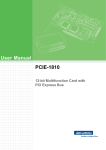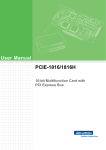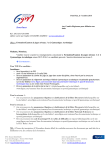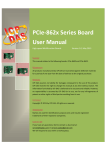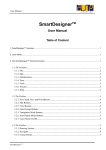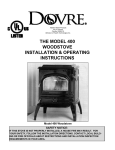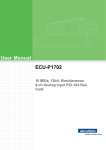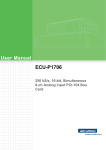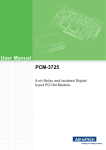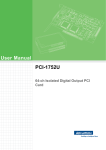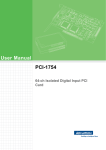Download User Manual PCIE-1802
Transcript
User Manual PCIE-1802 8-ch, 24-Bit, 216 kS/s Dynamic Signal Acquisition PCI Express Card Copyright The documentation and the software included with this product are copyrighted 2015 by Advantech Co., Ltd. All rights are reserved. Advantech Co., Ltd. reserves the right to make improvements in the products described in this manual at any time without notice. No part of this manual may be reproduced, copied, translated or transmitted in any form or by any means without the prior written permission of Advantech Co., Ltd. Information provided in this manual is intended to be accurate and reliable. However, Advantech Co., Ltd. assumes no responsibility for its use, nor for any infringements of the rights of third parties, which may result from its use. Acknowledgements Intel and Pentium are trademarks of Intel Corporation. Microsoft Windows and MS-DOS are registered trademarks of Microsoft Corp. All other product names or trademarks are properties of their respective owners. Product Warranty (2 years) Advantech warrants to you, the original purchaser, that each of its products will be free from defects in materials and workmanship for two years from the date of purchase. This warranty does not apply to any products which have been repaired or altered by persons other than repair personnel authorized by Advantech, or which have been subject to misuse, abuse, accident or improper installation. Advantech assumes no liability under the terms of this warranty as a consequence of such events. Because of Advantech’s high quality-control standards and rigorous testing, most of our customers never need to use our repair service. If an Advantech product is defective, it will be repaired or replaced at no charge during the warranty period. For outof-warranty repairs, you will be billed according to the cost of replacement materials, service time and freight. Please consult your dealer for more details. If you think you have a defective product, follow these steps: 1. Collect all the information about the problem encountered. (For example, CPU speed, Advantech products used, other hardware and software used, etc.) Note anything abnormal and list any onscreen messages you get when the problem occurs. 2. Call your dealer and describe the problem. Please have your manual, product, and any helpful information readily available. 3. If your product is diagnosed as defective, obtain an RMA (return merchandize authorization) number from your dealer. This allows us to process your return more quickly. 4. Carefully pack the defective product, a fully-completed Repair and Replacement Order Card and a photocopy proof of purchase date (such as your sales receipt) in a shippable container. A product returned without proof of the purchase date is not eligible for warranty service. 5. Write the RMA number visibly on the outside of the package and ship it prepaid to your dealer. PCIE-1802 User Manual Part No. 2003180200 Edition 1 Printed in Taiwan October 2015 ii Declaration of Conformity CE This product has passed the CE test for environmental specifications when shielded cables are used for external wiring. We recommend the use of shielded cables. This kind of cable is available from Advantech. Please contact your local supplier for ordering information. Technical Support and Assistance 1. 2. Visit the Advantech web site at http://support.advantech.com where you can find the latest information about the product. Contact your distributor, sales representative, or Advantech's customer service center for technical support if you need additional assistance. Please have the following information ready before you call: – Product name and serial number – Description of your peripheral attachments – Description of your software (operating system, version, application software, etc.) – A complete description of the problem – The exact wording of any error messages Packing List Before setting up the system, check that the items listed below are included and in good condition. If any item does not accord with the table, please contact your dealer immediately. PCIE-1802 DA&C card Startup or User Manual Companion DVD-ROM with DAQNavi drivers included Safety Precaution - Static Electricity Follow these simple precautions to protect yourself from harm and the products from damage. To avoid electrical shock, always disconnect the power from your PC chassis before you work on it. Don't touch any components on the CPU card or other cards while the PC is on. Disconnect power before making any configuration changes. The sudden rush of power as you connect a jumper or install a card may damage sensitive electronic components. iii PCIE-1802 User Manual PCIE-1802 User Manual iv Contents Chapter 1 Introduction..........................................1 1.1 1.2 Introduction ............................................................................................... 2 Features .................................................................................................... 2 1.2.1 Auto Calibration ............................................................................ 2 1.2.2 BoardID Switch ............................................................................. 2 Applications............................................................................................... 2 Installation Guide ...................................................................................... 3 Figure 1.1 Installation Flow Chart ................................................ 3 Software Overview .................................................................................... 3 1.5.1 Device Drivers............................................................................... 4 DAQNavi Device Driver Programming Roadmap ..................................... 4 1.6.1 Programming Tools....................................................................... 4 1.6.2 Programming with DAQNavi Device Drivers Function Library...... 5 1.6.3 Troubleshooting Device Drivers Error........................................... 5 Accessories............................................................................................... 5 1.7.1 Wiring Cables................................................................................ 5 1.7.2 Wiring Boards ............................................................................... 5 1.3 1.4 1.5 1.6 1.7 Chapter Chapter 2 Installation............................................7 2.1 2.2 2.3 Unpacking ................................................................................................. 8 Driver Installation ...................................................................................... 8 2.2.1 Device Auto Installation (Recommended)..................................... 9 Device Setup & Configuration ................................................................... 9 Figure 2.1 The Device Setting of PCIE-1802.............................. 9 Figure 2.2 The Device Setting page .......................................... 10 Figure 2.3 The Device Testing of PCIE-1802 ........................... 11 3 Signal Connections ...........................13 3.1 3.2 Overview ................................................................................................. 14 Jumper Settings ...................................................................................... 14 3.2.1 Setting the BoardID Switch (SW3900)........................................ 14 Table 3.1: Board ID Settings ..................................................... 14 3.2.2 Keep Last Status After Hot Reset (CN3901) .............................. 15 Table 3.2: Jumper Settings........................................................ 15 Signal Connections ................................................................................. 15 Figure 3.1 36-pin I/O Connector Pin Assignments .................... 15 Figure 3.2 19-pin I/O Connector Pin Assignments .................... 16 3.3.1 I/O Connector Signal Description................................................ 16 3.3.2 Analog Input Connections........................................................... 17 Table 3.3: Recommended Analog input Channel Configuration 17 Figure 3.3 AI Differential Input Signal Connection..................... 17 Figure 3.4 AI Pseudo-Differential Input Signal Connection ....... 18 Figure 3.5 AI IEPE Sensor Input Signal Connection ................. 18 3.3.3 Digital Input/Output Connections ................................................ 19 Figure 3.6 Digital Input Channel Connections ........................... 19 Figure 3.7 Digital Output Channel Connections ........................ 19 3.3.4 Trigger Type................................................................................ 20 Figure 3.8 Digital Trigger Signal Connection ............................. 20 Figure 3.9 Analog Trigger - Rising Edge ................................... 21 Figure 3.10Analog Trigger - Falling Edge................................... 21 3.3.5 Multiple Cards Synchronization Signal Connection .................... 22 3.3 v PCIE-1802 User Manual 3.4 Figure 3.11Multiple Cards Synchronization Signal Connection.. 22 Field Wiring Considerations .................................................................... 22 Appendix A Specifications.................................... 23 A.1 A.8 A.9 A.10 A.11 A.12 General Specifications ............................................................................ 24 A.1.1 Bus Interface............................................................................... 24 A.1.2 Power Requirements .................................................................. 24 A.1.3 Physical ...................................................................................... 24 A.1.4 Environmental............................................................................. 24 Input Characteristics ............................................................................... 24 A.2.1 Maximum Operating Voltage ...................................................... 25 A.2.2 Input Overvoltage Protection ...................................................... 25 A.2.3 Input Signal Range ..................................................................... 25 AC Coupled Measurement Accuracy...................................................... 26 Flatness .................................................................................................. 26 DC Coupled Measurement Accuracy...................................................... 26 Amplifier Characteristics ......................................................................... 26 A.6.1 Input Impedance ......................................................................... 26 A.6.2 Common-Mode Rejection Ratio (CMRR) ................................... 27 Dynamic Characteristics ......................................................................... 27 A.7.1 Bandwidth ................................................................................... 27 A.7.2 AC Coupling................................................................................ 28 Figure A.1 Magnitude response of AC coupling circuit .............. 28 Figure A.2 Phase response of AC coupling circuit..................... 28 A.7.3 Idle Channel Noise ..................................................................... 29 A.7.4 Representative Measurement FFTs ........................................... 29 Figure A.3 FFT of -1 dBFS, 1 kHz Tone Acquired at 54 kS/s. ... 29 Figure A.4 FFT of -1 dBFS, 1 kHz Tone Acquired at 108 kS/s. . 30 Figure A.5 FFT of -1 dBFS, 1 kHz Tone Acquired at 216 kS/s. . 30 A.7.5 Dynamic Range (DR).................................................................. 31 A.7.6 Spurious Free Dynamic Range (SFDR) ..................................... 31 A.7.7 Signal-to-Noise Ratio (SNR)....................................................... 31 A.7.8 Total Harmonic Distortion (THD) ................................................ 32 A.7.9 Total Harmonic Distortion Plus Noise (THD+N) ......................... 32 A.7.10 Crosstalk..................................................................................... 32 A.7.11 Inter-channel Gain Mismatch...................................................... 33 A.7.12 Inter-channel Phase Mismatch ................................................... 33 Integrated Electronic Piezoelectric Excitation (IEPE) ............................. 33 Reference Clock Characteristics............................................................. 33 Triggers................................................................................................... 34 Digital I/O ................................................................................................ 34 Synchronization Input & Output .............................................................. 34 Appendix B Block Diagram................................... 35 B.1 Function Block Diagrams ........................................................................ 36 Figure B.1 Function block diagram - overview........................... 36 Figure B.2 Function block diagram - analog input ..................... 36 A.2 A.3 A.4 A.5 A.6 A.7 PCIE-1802 User Manual vi Chapter 1 1 Introduction This chapter will provide information on the features of the PCIE1802 cards, a quick installation guide, together with some brief information on software and accessories. Sections include: Features Applications Installation Guide Software Overview Device Drivers Programming Roadmap Accessories 1.1 Introduction The Advantech PCIE-1802 is a high-performance data acquisition module specifically designed for sound and vibration applications. With eight 24 bit analog inputs per module and IEPE constant current signal conditioning, Advantech’s PCIE-1802 is ideal for making precision measurements with microphones, accelerometers, and other transducers that have very large dynamic ranges. The modules deliver 115 dB of dynamic range and simultaneous sampling on all 8 channels at rates up to 216 kS/ s. 1.2 Features The PCIE-1802 offers the following main features: 8 simultaneous analog input channels 24-bit resolution A/D converter 216 kS/s maximum sampling rate 115 dB dynamic range up to 6 gain settings for ranges from ±200 mV to ±10 V IEPE for accelerometers and microphones Some of the features are described in detail on the following pages. 1.2.1 Auto Calibration The PCIE-1802 card features software auto calibration. It provides a convenient method for user calibration processing. 1.2.2 BoardID Switch The PCIE-1802 has a built-in DIP switch that helps define each card’s ID when multiple PCIE-1802 cards have been installed on the same PC chassis. The BoardID setting function is very useful when building a system with multiple PCIE-1802 cards. With the correct BoardID settings, you can easily identify and access each card during hardware configuration and software programming. Note! For detailed specifications of the PCIE-1802 card, refer to Appendix A, Specifications. 1.3 Applications The following are some of the possible applications of PCIE-1802 cards: Noise, vibration, and harshness (NVH) detection Machine status monitoring Structural health monitoring PCIE-1802 User Manual 2 Figure 1.1 Installation Flow Chart 1.5 Software Overview Advantech offers a rich set of APIs, third-party driver supports and application software to help fully utilize the functions of your PCIE-1802 cards: Device Drivers (on the companion DVD-ROM) DAQNavi SDK 3 PCIE-1802 User Manual Introduction Before you install your PCIE-1802 card, please make sure you have the following components: PCIE-1802 DA&C card PCIE-1802 Startup Manual Driver software Advantech DAQNavi SDK and drivers (included in the companion CD-ROM) Wiring cables PCL-108BC-50E (optional) PCL-10119-1E (optional) Wiring board PCLD-8840 (optional) Personal computer or workstation with a PCI Express interface (running Windows8 (desktop mode), 7 and XP) Some optional components are also available for enhanced operation: After you get the necessary components and maybe some of the accessories for enhanced operation of your Multifunction card, you can then begin the installation procedures. Figure 1.1 on the next page provides a concise flow chart for a broad picture of the software and hardware installation procedure: Chapter 1 1.4 Installation Guide 1.5.1 Device Drivers Advantech Device Driver software is included on the companion CD-ROM. It also comes with all Advantech DA&C cards. Advantech’s device drivers feature a complete I/O function library to help boost your application performance. The Advantech Device Drivers for Windows 2000, XP, Vista or Windows 7 works seamlessly with development tools such as Visual C++, Visual C#, Visual Basic.NET, Borland C++ Builder and Borland Delphi. 1.6 DAQNavi Device Driver Programming Roadmap This section will provide you with a roadmap to demonstrate how to build an application from scratch using Advantech DAQNavi Device Driver with your favorite development tools such as Visual Studio.Net, Visual C++, Visual Basic, Delphi and C++ Builder. The step-by-step instructions on how to build your own applications using each development tool will be given in the Device Drivers Manual. Moreover, a rich set of example source code is also given for your reference. 1.6.1 Programming Tools Programmers can develop application programs with their favorite development tools: Visual Studio.Net Visual C++ and Visual Basic Delphi C++ Builder For instructions on how to begin programming works in each development tool, Advantech offers a Tutorial Chapter in the DAQNavi SDK Manual for your reference. Refer to the corresponding sections in this chapter on the DAQNavi SDK Manual to begin your programming efforts. You can also look at the example source code provided for each programming tool, since they can get you very well oriented. The DAQNavi SDK Manual can be found on the companion DVD-ROM. Alternatively, if you have already installed the Device Drivers on your system, The DAQNavi SDK Manual can be readily accessed through the Start button: Start/Programs/Advantech Automation/DAQNavi/DAQNavi Manuals/DAQNavi SDK Manual The example source codes can be found under the corresponding installation folder such as the default installation path: C:\Advantech\DAQNavi\Examples\ For information about using other function groups or other evelopment tools, please refer to the Using DAQNavi SDK chapter in the DAQNavi SDK Manual, or the video tutorials in the Advantech Navigator. PCIE-1802 User Manual 4 1.6.3 Troubleshooting Device Drivers Error Driver functions will return a status code when they are called to perform a certain task for the application. When a function returns a code that is not zero, it means the function has failed to perform its designated function. See Device Driver Manual for detailed information about Error Code. 1.7 Accessories Advantech offers a complete set of accessory products to support PCIE-1802 cards. These accessories include: 1.7.1 Wiring Cables PCL-108BC-50E 36-pin MINI SCSI to Eight BNC Cable, 0.5 m PCL-10119-1E HDMI Cable, 1 m 1.7.2 Wiring Boards PCLD-8840-AE 20-pin DIN-rail HDMI Cable Wiring Board for PCIE-1802 and PCIE-1840. 5 PCIE-1802 User Manual Introduction Advantech DAQNavi Device Drivers offer a rich function library that can be utilized in various application programs. This function library consists of numerous APIs that support many development tools, such as Visual Studio.Net, Visual C++, Visual Basic, Delphi and C++ Builder. According to their specific functions or services, APIs can be categorized into several function groups: Analog Input Function Group Digital Input/Output Function Group Event Function Group For the usage and parameters of each function, please refer to the Using DAQNavi SDK chapter in the DAQNavi SDK Manual. Chapter 1 1.6.2 Programming with DAQNavi Device Drivers Function Library PCIE-1802 User Manual 6 Chapter 2 Installation 2 2.1 Unpacking After receiving your PCIE-1802 package, inspect its contents first. The package should contain the following items: PCIE-1802 card Companion CD-ROM (DLL driver included) Startup Manual The PCIE-1802 cards harbors certain electronic components vulnerable to electrostatic discharge (ESD). ESD could easily damage the integrated circuits and certain components if preventive measures are not carefully paid attention to. Before removing the card from the antistatic plastic bag, you should take following precautions to prevent ESD damage: Touch a metal part of your computer chassis with your hand to discharge static electricity accumulated on your body. Or use a grounding strap. Touch the anti-static bag to a metal part of your computer chassis before opening the bag. Hold the card only by the metal bracket when removing it from the bag. After taking out the card, you should first inspect the card for any possible signs of external damage (loose or damaged components, etc.). If the card is visibly damaged, please notify our service department or the local sales representative immediately. Avoid installing a damaged card into your system. Also, pay extra caution to the following aspects to ensure proper installation: Avoid physical contact with materials that could hold static electricity such as plastic, vinyl and Styrofoam. Whenever you handle the card, grasp it only by its edges. DO NOT TOUCH the exposed metal pins of the connector or the electronic components. Note! Keep the anti-static bag for future use. You may need the original bag to store the card if you have to remove the card from the PC or transport it elsewhere. 2.2 Driver Installation We recommend you install the driver before you install the PCIE-1802 card into your system, since this will guarantee a smooth installation process. The Advantech DAQNavi Device Drivers Setup program for the PCIE-1802 card is included in the companion DVD-ROM that is shipped with your DA&C card package. Please follow the steps below to install the driver software: 1. Insert the companion DVD-ROM into your DVD-ROM drive. 2. The Setup program will be launched automatically if you have the auto play function enabled on your system. When the Setup Program is launched, you can follow the installation guide to correctly install the driver step by step. PCIE-1802 User Manual 8 2.3 Device Setup & Configuration The Advantech Navigator program is a utility that allows you to set up, configure and test your device, and later stores your settings on the system registry. These settings will be used when you call the APIs of Advantech Device Drivers. Setting Up the Device 1. To install the I/O device for your card, you must first run the Advantech Navigator program (by accessing Start/Programs/Advantech Automation/DAQNavi/ Advantech Navigator). 2. You can then view the device(s) already installed on your system (if any) on the Installed Devices list box. If the software and hardware installation are completed, you will see PCIE-1802 card in the Installed Devices list. Figure 2.1 The Device Setting of PCIE-1802 9 PCIE-1802 User Manual Installation You can install the PCIE-1802 module in any PCI Express slot on your computer. Follow the steps below to install the module on your system. 1. Turn off your computer and unplug the power cord and cables. TURN OFF your computer before installing or removing any components on the computer. 2. Remove the cover of the computer. 3. Remove the slot cover on the back panel of your computer. 4. Touch the metal part on the surface of your computer to neutralize the static electricity that might be on your body. 5. Insert the PCIE-1802 card into a PCI Express slot. Hold the card only by its edges and carefully align it with the slot. Insert the card firmly into place. Use of excessive force must be avoided, otherwise the card might be damaged. 6. Fasten the bracket of the PCI card on the back panel rail of the computer with screws. 7. Plug in the power cord and turn on the computer. Chapter 2 2.2.1 Device Auto Installation (Recommended) Configuring the Device Go to the Device Setting to configure your device. Here you can configure not only the Analog Input of PCIE-1802 but also Digital Input/Output. Figure 2.2 The Device Setting page PCIE-1802 User Manual 10 Chapter 2 After your card is properly installed and configured, you can go to the Device Test page to test your hardware by using the testing utility supplied. Installation Figure 2.3 The Device Testing of PCIE-1802 For more detailed information, refer to the DAQNavi SDK Manual or the User Interface Manual in the Advantech Navigator. 11 PCIE-1802 User Manual PCIE-1802 User Manual 12 Chapter 3 3 Signal Connections This chapter provides useful information about how to connect input and output signals to the PCIE-1802 cards via the I/O connector. Sections include: Overview Switch Settings Signal Connections Field Wiring Considerations 3.1 Overview Maintaining signal connections is one of the most important factors in ensuring that your application system is sending and receiving data correctly. A good signal connection can avoid unnecessary and costly damage to your PC and other hardware devices. This chapter provides useful information about how to connect input and output signals to the PCIE-1802 cards via the I/O connector. 3.2 Jumper Settings 3.2.1 Setting the BoardID Switch (SW3900) The PCIE-1802 has a built-in DIP switch (SW3900), which is used to define each card's board ID. You can determine the board ID on the register as shown in Table 2.1. When there are multiple cards on the same chassis, this board ID setting function is useful for identifying each card's device number through board ID. We set the PCIE-1802 board ID as 0 at the factory. If you need to adjust it to other board ID, set the SW3900 by referring to DIP switch setting. Table 3.1: Board ID Settings SW3900 3 2 1 0 BoardID ID3 ID2 ID1 ID0 0* ON ON ON ON 1 ON ON ON OFF 2 ON ON OFF ON 3 ON ON OFF OFF 4 ON OFF ON ON 5 ON OFF ON OFF 6 ON OFF OFF ON 7 ON OFF OFF OFF 8 OFF ON ON ON 9 OFF ON ON OFF 10 OFF ON OFF ON 11 OFF ON OFF OFF 12 OFF OFF ON ON 13 OFF OFF ON OFF 14 OFF OFF OFF ON 15 OFF OFF OFF OFF * Default Setting PCIE-1802 User Manual 14 If “Keep last status after hot reset” is selected, the status of DOs will be kept after hot reset. On the other hand, if “Default configuration” is selected, the status of DOs will be reset to the default values (low). Table 3.2: Jumper Settings Name of Jumpers Chapter 3 3.2.2 Keep Last Status After Hot Reset (CN3901) Function Description CN3901 Default configuration (default) 3.3 Signal Connections Pin Assignment The I/O connector on the PCIE-1802 are a 36-pin and 19-pin connectors that enable you to connect to accessories with the PCL-108BNC mini SCSI and PCL-10119 HDMI cable. Figure 3.1 and Figure 3.2 show the pin assignments for the 36-pin and 19-pin I/O connector separately, and Table 3.1 shows its I/O connector signal description. Figure 3.1 36-pin I/O Connector Pin Assignments 15 PCIE-1802 User Manual Signal Connections Keep last status after hot reset Figure 3.2 19-pin I/O Connector Pin Assignments 3.3.1 I/O Connector Signal Description Signal Name Reference Direction Description AI<0..7>+ AGND Input Analog positive input channels 0 through 7 AI<0..7>- AGND Input Analog negative input channels 0 through 7 AGND ---- ---- Analog ground REF_CLK_IN DGND Input 25 MHz reference clock input REF_CLK_OUT DGND Output 25 MHz reference clock output DTRG<0..1> DGND Input Digital trigger inputs TRIGOUT<0..1> DGND Output Trigger outputs SYNC_IN DGND Input Synchronization input SYNC_OUT DGND Output Synchronization output DI0 DGND Input Digital input channel DO<0..1> DGND Output Digital output channels DGND ---- ---- Digital ground PCIE-1802 User Manual 16 The default configuration of the PCIE-1802 is differential. Table 3.3: Recommended Analog input Channel Configuration Source Reference Channel Configuration Floating Pseudo-differential Grounded Differential Figure 3.3 AI Differential Input Signal Connection 17 PCIE-1802 User Manual Signal Connections 3.3.2.1 Differential Inputs The PCIE-1802 supports two terminal configurations for analog input: differential and pseudo-differential. The term pseudo-differential refers to the 50 Ω resistance between the outer connector shell and chassis ground. If the signal source is floating, use the pseudo-differential configuration. The pseudodifferential configuration provides a ground reference between the floating source and the PCIE-1802 by connecting a 50 Ω resistor from the negative input to ground. Without this, the floating source can drift outside of the input common-mode range of the PCIE-1802. If the signal source is grounded or ground referenced, both the pseudo-differential and differential input configurations are acceptable. However, the differential input configuration is preferred, since using the pseudo-differential input configuration on a grounded signal source creates more than one ground-reference point. This condition may allow ground loop current, which can introduce errors or noise into the measurement. The 50 Ω resistor between the negative input and ground is usually sufficient to reduce these errors to negligible levels, but results can vary depending on your system setup. Configure the channels based on the signal source reference or DUT configuration. Refer to Table 1-1 to determine how to configure the channel. Chapter 3 3.3.2 Analog Input Connections 3.3.2.2 Pseudo-Differential Inputs A pseudo-differential input is much like a differential input in that it provides commonmode voltage rejection (unlike single-ended inputs). However, pseudo-differential inputs are all referred, but not directly tied, to a common ground. This connection is typically made by a relatively low value resistor to give some isolation between the sensor/signal ground and the measurement device ground. DSA measurement devices have a 50 Ω resistance between the negative signal connector the outer shell of a BNC, and the device ground. A diagram showing the pseudo-differential input configuration of the PCIE-1802 is shown below with a floating source. Figure 3.4 AI Pseudo-Differential Input Signal Connection 3.3.2.3 IEPE for Input For applications that require sensors such as microphones or accelerometers, the PCIE-1802 provides an excitation current source to excite IEPE sensors. A DC voltage offset is generated due to the excitation current and sensor impedance. When IEPE current sources are enabled, the PCIE-1802 automatically sets input configuration to AC coupling and pseudo-differential. Figure 3.5 AI IEPE Sensor Input Signal Connection PCIE-1802 User Manual 18 Chapter 3 3.3.3 Digital Input/Output Connections PCIE-1802 provides 2 Channels DO and 1 channel DI. 3.3.3.1 Digital Input Channel Connections 3.3.3.2 Digital Output Channel Connections Figure 3.7 Digital Output Channel Connections 19 PCIE-1802 User Manual Signal Connections Figure 3.6 Digital Input Channel Connections 3.3.4 Trigger Type The PCIE-1802 supports two types of triggers: start triggers and stop triggers. The returned data consists of samples acquired between a start trigger and a stop trigger. That is, only data acquired after the start trigger occurred and before the stop trigger occurred are returned. Both start triggers and stop triggers can be delayed. When the delay number is applied to a trigger, the trigger is effective only when the number of samples has reached after the trigger occurs. For example, if delay number of 5 is applied to the start trigger, the returned data will consist of samples acquired after the start trigger occurred except the first 5 samples. If delay number of 3 is applied to the stop trigger, the returned data will consist of samples acquired before the stop trigger occurred plus 3 samples acquired after the stop trigger. Both triggers can be configured independently, and can be set to use a variety of sources, both analog and digital. Triggers can be configured to occur on either the rising or falling edge of a signal. Moreover, analog triggers support other modes of operation, including triggering on edges with hysteresis, and triggering when a signal enters or leaves a predefined window. Since all three types of triggers are configured independently, alternate edges of a signal can be used for different types of triggers. During repetitive triggering on a waveform, you might observe jitter because of the uncertainty of where a trigger level falls compared to the actual digitized data. Although this trigger jitter is never greater than one sample period, it might be significant when the sample rate is only twice the bandwidth of interest. This jitter usually has no effect on data processing, and you can decrease this jitter by sampling at a higher rate. 3.3.4.1 Digital Trigger Connections You can configure the PCIE-1802 to trigger in response to digital signals on DTRG0 or DTRG1 pin of the HDMI connector, located on the device front panel. The trigger circuit can respond either to a rising or a falling edge. The trigger signal must comply to 3.3 V or 5 V TTL voltage levels. A diagram showing the DRTG input configuration of the PCIE-1802 is shown below with a signal source. Figure 3.8 Digital Trigger Signal Connection PCIE-1802 User Manual 20 Figure 3.9 Analog Trigger - Rising Edge Analog Trigger- Falling Edge For falling edge trigger, ±10 V input range, +2 V trigger level, 0.1% trigger hysteresis (equivalent to 20 V × 0.1% = 0.02 V). Figure 3.10 Analog Trigger - Falling Edge 21 PCIE-1802 User Manual Signal Connections Analog Trigger- Rising Edge For rising edge trigger, ±10 V input range, +2 V trigger level, 0.1% trigger hysteresis (equivalent to 20 V × 0.1% = 0.02 V). Chapter 3 3.3.4.2 Analog Trigger You can configure the PCIE-1802 analog trigger circuitry to monitor any input channel from which you acquire data. Choosing an input channel as the trigger channel does not influence the input channel acquisition capabilities. The trigger circuit generates an internal digital trigger based on the input signal and the defined trigger levels. For example, you can configure the device to start acquiring samples after the input signal crosses a specific threshold. PCIE-1802 offers several analog triggering modes, including analog edge, analog edge with hysteresis, and window triggering. Analog trigger connections are the same as Analog Input Connections, please refer to differential input (Figure 3.3) or pseudo-differential input (Figure 3.4). 3.3.5 Multiple Cards Synchronization Signal Connection The below figure shows how to synchronize multiple PCIE-1802 cards. The synchronization is done through the reference clock and synchronization signal lines. The boards in both master and slave, share the same clock, sync pulse and a start trigger. Figure 3.11 Multiple Cards Synchronization Signal Connection 3.4 Field Wiring Considerations When you use PCIE-1802 cards to acquire data from outside, noises in the environment might significantly affect the accuracy of your measurements if due cautions are not taken. The following measures will be helpful to reduce possible interference running signal wires between signal sources and the PCIE-1802 card. The signal cables must be kept away from strong electromagnetic sources such as power lines, large electric motors, circuit breakers or welding machines, since they may cause strong electromagnetic interference.Keep the analog signal cables away from any video monitor, since it can significantly affect a data acquisition system. If the cable travels through an area with significant electromagnetic interference, you should adopt individually shielded, twisted-pair wires as the analog input cable. This type of cable has its signal wires twisted together and shielded with a metal mesh. The metal mesh should only be connected to one point at the signal source ground. Avoid running the signal cables through any conduit that might have power lines in it. If you have to place your signal cable parallel to a power line that has a high voltage or high current running through it, try to keep a safe distance between them. Alternatively, you can place the signal cable at a right angle to the power line to minimize the undesirable effect. The signals transmitted on the cable will be directly affected by the quality of the cable. In order to ensure better signal quality, we recommend that you use the PCL-108BC-50E shielded cable. PCIE-1802 User Manual 22 Appendix A Specifications A A.1 General Specifications A.1.1 Bus Interface Form factor: x1 PCI Express, specification v1.1 compliant Slot compatibility: x1, x4, x8, and x16 PCI Express slots DMA channel: 1, analog input A.1.2 Power Requirements Typical: +3.3 V @ 400 mA, +12 V @ 850 mA A.1.3 Physical Printed circuits board dimensions: 9.9 × 16.8 cm (3.9 × 6.6 in.) I/O connector: 1 × 36-pin VHDCI (mini-SCSI), and 1 × HDMI A.1.4 Environmental Operating temperature: 0 to 60°C Storage temperature: -40 to 70°C Operating humidity: 10 to 90% RH, non-condensing Storage humidity: 5 to 95% RH, non-condensing Indoor use only. A.2 Input Characteristics Number of simultaneously sampled input channels: 8, can be enabled/disabled each channel independently by software Input configuration: Differential/Pseudo-differential (50 Ω between negative input and chassis ground), software selectable per channel Input coupling: AC/DC, software selectable per channel A/D converter (ADC) resolution: 24 bits A/D converter (ADC) type: Delta-sigma Sample rates (fs): – Range: 100 S/s to 216 kS/s – Resolution: 90.95 μS/s (100 S/s to 54 kS/s) 181.90 μS/s (54 kS/s to 108 kS/s) 363.80 μS/s (108 kS/s to 216 kS/s) FIFO buffer size: 4,096 samples Data transfers: Direct memory access (DMA) PCIE-1802 User Manual 24 IEPE Input Coupling Input Configuration Positive Terminal (+)* Negative Terminal (-)* Disabled AC Differential ±24 V ±24 V Disabled AC Pseudo-differential ±24 V ±10 V Disabled DC Differential ±10 V ±10 V Disabled DC Pseudo-differential ±10 V ±10 V Enabled AC Pseudo-differential 0 ~ +24 V 0 ~ +1 V Enabled DC Pseudo-differential 0 ~ +10 V 0 ~ +1 V * Voltages with respect to chassis ground. Note! Input configuration must be pseudo-differential when IEPE is enabled. A.2.2 Input Overvoltage Protection Input Configuration Positive Terminal (+)* Negative Terminal (-)* Differential ±24 V ±24 V Pseudo-differential ±24 V ±12 V * Voltages with respect to chassis ground. A.2.3 Input Signal Range Gain Full-Scale Range*, ** 0.28 ±10.0 V 0.56 ±5.0 V 1.4 ±2.0 V 2.8 ±1.0 V 5.6 ±0.5 V 14 ±0.2 V *Each input channel gain is independently software selectable. **Voltages on the positive terminal with respect to the negative terminal. 25 PCIE-1802 User Manual Appendix A Specifications A.2.1 Maximum Operating Voltage A.3 AC Coupled Measurement Accuracy Gain error (fin = 1 kHz): – Operating temperature within 5 °C of last auto-calibration temperature: < ±0.6% – Over full operating temperature range: < ±1.0% Offset error: – Operating temperature within 5 °C of last auto-calibration temperature: < ±1.0 mV – Over full operating temperature range: < ±1.5 mV Note! For the best measurement accuracy, it is recommended warming up the PCIE-1802 for 15 minutes before starting data acquisition. A.4 Flatness Frequency Band fs ≥ 54 kS/s 20 Hz ≤ fin ≤ 20 kHz fs ≥ 108 kS/s fs ≥ 216 kS/s 20 kHz < fin ≤ 45 kHz 45 kHz < fin ≤ 92.2 kHz Flatness* (dB) ±0.004 ±0.006 ±0.008 * Relative to 1 kHz. A.5 DC Coupled Measurement Accuracy Gain error: – Operating temperature within 5 °C of last auto-calibration temperature: < ±0.2% – Over full operating temperature range: < ±0.4% Offset error: – Operating temperature within 5 °C of last auto-calibration temperature: < 0.5 mV – Over full operating temperature range: < 1 mV Note! For the best measurement accuracy, it is recommended warming up the PCIE-1802 for 15 minutes before starting data acquisition. A.6 Amplifier Characteristics A.6.1 Input Impedance Input Configuration Between Positive Terminal (+) and Chassis Ground Between Negative Terminal (-) and Chassis Ground Differential 1 MΩ 1 MΩ Pseudo-differential 1 MΩ 50 Ω PCIE-1802 User Manual 26 Input frequency < 20 kHz: 80 dB A.7 Dynamic Characteristics A.7.1 Bandwidth Sample Rate fs < 25.6 kS/s fs ≥ 25.6 kS/s Alias rejection > 90 dB > 90 dB -3 dB bandwidth 0.4805 × fs 0.4852 × fs *fs: Sample frequency For example, the -3 dB bandwidth of 10 kS/s sample frequency is 0.4805 × 10 kHz = 4.805 kHz. 27 PCIE-1802 User Manual Appendix A Specifications A.6.2 Common-Mode Rejection Ratio (CMRR) A.7.2 AC Coupling -3 dB cutoff frequency : 0.727 Hz -0.1 dB cutoff frequency: 4.727 Hz Figure A.1 Magnitude response of AC coupling circuit Figure A.2 Phase response of AC coupling circuit. PCIE-1802 User Manual 28 Input Range 54 kS/s 108 kS/s 216 kS/s LSBrms μVrms LSBrms μVrms LSBrms μVrms ±10.0 V 6.59 7.86 9.50 11.32 60.80 72.48 ±5.0 V 6.87 4.09 9.85 5.87 60.75 36.21 ±2.0 V 7.84 1.87 11.31 2.70 60.83 14.50 ±1.0 V 9.92 1.18 14.36 1.71 63.22 7.54 ±0.5 V 14.49 0.86 21.13 1.26 66.13 3.94 ±0.2 V 30.47 0.73 42.85 1.02 85.09 2.03 A.7.4 Representative Measurement FFTs Test conditions for all FFTs: 10 RMS averages of 65,536 samples using a 7-term Blackman-Harris window at ±10 V input range. Source: Krohn-Hite 4402B. Figure A.3 FFT of -1 dBFS, 1 kHz Tone Acquired at 54 kS/s. 29 PCIE-1802 User Manual Appendix A Specifications A.7.3 Idle Channel Noise Figure A.4 FFT of -1 dBFS, 1 kHz Tone Acquired at 108 kS/s. Figure A.5 FFT of -1 dBFS, 1 kHz Tone Acquired at 216 kS/s. PCIE-1802 User Manual 30 Input Range Dynamic Range (dB)* fs = 54 kS/s fs = 108 kS/s fs = 216 kS/s ±10.0 V 117 114 100 ±5.0 V 114 112 98 ±2.0 V 108 107 98 ±1.0 V 105 102 96 ±0.5 V 96 96 92 ±0.2 V 88 88 86 * 1 kHz input tone, unweighted. Input amplitude is -60 dBFS. A.7.6 Spurious Free Dynamic Range (SFDR) Input Range Spurious Free Dynamic Range (dBc)*,** fs = 54 kS/s fs = 108 kS/s fs = 216 kS/s ±10.0 V 104 105 104 ±5.0 V 106 106 106 ±2.0 V 106 106 106 ±1.0 V 104 102 102 ±0.5 V 97 97 96 ±0.2 V 89 89 89 * 1 kHz input tone, input amplitude is -1 dBFS. ** Measurement includes all harmonics. A.7.7 Signal-to-Noise Ratio (SNR) Input Range Signal-to-Noise Ratio (dB)* fs = 54 kS/s fs = 108 kS/s fs = 216 kS/s ±10.0 V 99 99 97 ±5.0 V 100 100 97 ±2.0 V 99 99 96 ±1.0 V 97 97 94 ±0.5 V 93 92 89 ±0.2 V 86 85 82 * 1 kHz input tone, input amplitude is -1 dBFS. 31 PCIE-1802 User Manual Appendix A Specifications A.7.5 Dynamic Range (DR) A.7.8 Total Harmonic Distortion (THD) Input Range Total Harmonic Distortion (dB)* fs = 54 kS/s fs = 108 kS/s fs = 216 kS/s ±10.0 V -103 -104 -103 ±5.0 V -106 -106 -106 ±2.0 V -107 -107 -107 ±1.0 V -105 -105 -105 ±0.5 V -102 -101 -101 ±0.2 V -95 -95 -95 * 1 kHz input tone, input amplitude is -1 dBFS. A.7.9 Total Harmonic Distortion Plus Noise (THD+N) Input Range Total Harmonic Distortion Plus Noise (dB)* fs = 54 kS/s fs = 108 kS/s fs = 216 kS/s ±10.0 V -98 -98 -96 ±5.0 V -99 -99 -96 ±2.0 V -98 -98 -96 ±1.0 V -96 -96 -94 ±0.5 V -93 -91 -89 ±0.2 V -86 -84 -82 * 1 kHz input tone, input amplitude is -1 dBFS. A.7.10Crosstalk Input Range Crosstalk for Adjacent (Non-adjacent) Channels (dBc)*, ** 54 kS/s, fin = 1 kHz 216 kS/s, fin = 92.2 kHz ±10.0 V -139 (-158) -128 (-137) ±5.0 V -149 (-157) -109 (-132) ±2.0 V -149 (-155) -110 (-133) ±1.0 V -144 (-154) -113 (-136) ±0.5 V -144 (-152) -118 (-135) ±0.2 V -143 (-144) -124 (-135) * Input amplitude is -1 dBFS. ** Using the Mini-SCSI 36-pin to 8-BNC cable assembly. PCIE-1802 User Manual 32 Input Range AC/DC Coupled Mismatch (dB)*, ** fin = 10 Hz fin = 100 Hz fin = 20 kHz fin = 92.2 kHz ±10.0 V < 0.005 < 0.005 < 0.005 < 0.005 ±5.0 V < 0.005 < 0.005 < 0.005 < 0.005 ±2.0 V < 0.005 < 0.005 < 0.005 < 0.005 ±1.0 V < 0.005 < 0.005 < 0.005 < 0.005 ±0.5 V < 0.005 < 0.005 < 0.005 < 0.005 ±0.2 V < 0.02 < 0.01 < 0.01 < 0.02 * Identical channel configurations. ** Operating temperature within 5 °C of last auto-calibration temperature. A.7.12Inter-channel Phase Mismatch Input Range AC/DC Coupled Mismatch*, ** fin = 10 Hz fin = 100 Hz fin = 20 kHz fin = 92.2 kHz ±10.0 V < 0.01° < 0.005° < 0.01° < 0.04° ±5.0 V < 0.01° < 0.005° < 0.02° < 0.06° ±2.0 V < 0.01° < 0.005° < 0.02° < 0.06° ±1.0 V < 0.01° < 0.005° < 0.02° < 0.08° ±0.5 V < 0.01° < 0.005° < 0.02° < 0.08° ±0.2 V < 0.01° < 0.005° < 0.03° < 0.11° * Identical channel configurations. ** Operating temperature within 5 °C of last auto-calibration temperature. A.8 Integrated Electronic Piezoelectric Excitation (IEPE) Current: 0, 4, or 10 mA ± 5%, each channel independently software selectable Compliance: 24 V min Channel input impedance with IEPE enabled: 200 kΩ @ 1 kHz, pseudo-differential A.9 Reference Clock Characteristics Using external reference clock (25 MHz): – Accuracy: Equal to accuracy of external reference clock Using internal reference clock: – Accuracy: ±20 ppm, over operating temperature range, in first year – Aging: 3 ppm/year 33 PCIE-1802 User Manual Appendix A Specifications A.7.11 Inter-channel Gain Mismatch A.10 Triggers Analog trigger input: – Type: Start, delay to start, stop, or delay to stop trigger – Source: Any analog input channel – Level: Full scale, programmable – Slope: Positive (rising) or negative (falling), software selectable – Resolution: 24 bits – Hysteresis: Programmable Digital trigger input: – Type: Start, delay to start, stop, or delay to stop trigger – Source: 2 external digital trigger inputs – Compatibility: 3.3 V CMOS, 5 V compatible Low: 0.8 V max. High: 2.0 V min. – Pull-down resistor: 50 kΩ – Polarity: Rising or falling edge, software selectable – Minimum pulse width: 20 ns Digital trigger output: – Number of digital trigger output: 2 – Source: Analog trigger input, digital trigger input, or software trigger – Compatibility: 3.3 V CMOS Low: 0.6 V max. High: 2.3 V min. A.11 Digital I/O Digital Input: – Number of digital input: 1 – Number of Interrupt: 1 – Compatibility: 3.3 V CMOS Low: 0.6 V max. High: 2.3 V min. – Pull-down resistor: 50 kΩ Digital Output: – Number of digital output: 2 – Compatibility: 3.3 V CMOS Low: 0.6 V max. High: 2.3 V min. A.12 Synchronization Input & Output Synchronization Input: – Compatibility: 3.3 V CMOS, 5 V compatible – Pull-down resistor: 50 kΩ Synchronization Output: – Compatibility: 3.3 V CMOS Low: 0.6 V max. High: 2.3 V min. PCIE-1802 User Manual 34 Appendix B Block Diagram B B.1 Function Block Diagrams Figure B.1 Function block diagram - overview Figure B.2 Function block diagram - analog input PCIE-1802 User Manual 36 Appendix B Block Diagram PCIE-1802 User Manual 37 www.advantech.com Please verify specifications before quoting. This guide is intended for reference purposes only. All product specifications are subject to change without notice. No part of this publication may be reproduced in any form or by any means, electronic, photocopying, recording or otherwise, without prior written permission of the publisher. All brand and product names are trademarks or registered trademarks of their respective companies. © Advantech Co., Ltd. 2015















































